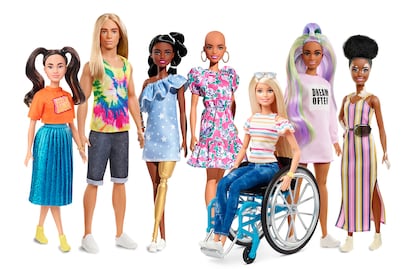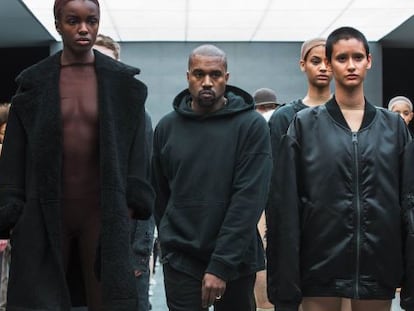Barbie, the money-making machine
The blonde doll has had to change with the times to survive, and there have been a lot of bumps in the road. Despite this, it still represented 27% of Mattel’s total revenue

Barbie and Mattel go hand in hand. The success of the toy company that created her over 60 years ago still largely rests on her slim plastic shoulders. While the company performed well and kept the business balanced with other brands during some of the doll’s low moments, Barbie remains fundamental to the toy company’s success. “Of course, Barbie is the queen of our product portfolio and, to some extent, an indicator of how Mattel is doing,” Richard Dickson, the company’s president and Chief Operating Officer (COO), said by video call.
Dickson did not disclose the Barbie brand’s share of the company’s revenues, which were $5.458 billion (a similar figure in euros) in 2021 (that figure was $6.081 billion before discounts, returns and other adjustments). However, the company’s annual report sheds some light on the matter. The doll division accounted for almost $2.3 billion of Mattel’s gross revenues; Barbie alone represented $1.679 billion, or 73% of the sales in its category, and about 27% of total revenue. “Last year, it reached the highest level in its history,” Dickson confirmed. Indeed, Mattel recorded profits of $903 million versus $123 million the previous year, a 19% increase from 2020.
Barbie has returned to the spotlight. “We are experiencing big [sales] increases around the world.” But the blonde doll with unrealistic measurements has had to change with the times to survive, and there have been a lot of bumps in the road. “The brand has had a great run, a very impressive run, but it’s also faced a lot of controversy,” Dickson explained.
More than six decades ago, when toys were even more heavily gendered, Mattel co-founder Ruth Handler saw that her son, Kenneth, had more options to play with than her daughter, Barbara. While he could be an astronaut or a surgeon, Barbara was left to entertain herself primarily with baby dolls, which reflected what society had in store for her later. “Ruth would watch her daughter play with paper dolls, and she noticed that her daughter and her friends imagined what they would be in the future as they played.” Thus, Barbie was born in 1959, intended as a way to unleash the imagination and potential of young girls.
Although Barbie was a gender-bound representation of women, at that time and in that social context, the doll was presented as a tool for girls to project themselves into environments beyond the home and caregiving. “As time went on, [Barbie] was always on the cusp of what we can refer to as the cultural conversation. In the 1960s, Barbie represented a lot of the aspirations of what was going on [at the time],” noted the Mattel president. “She began to study, and her clothes represented the career that little girls could imagine themselves pursuing. As time went by, Barbie and her style progressed.”
Criticism
Over time, criticisms of Barbie’s body and influence on childhood also increased. In 1965, the same year her astronaut outfit was introduced, Mattel marketed a sleepover set. The set came with a scale that read 110 pounds (50 kilos) and a book whose front cover read “How to lose weight?” with the answer “Don’t eat!” on the back cover. In the early 1990s, a new talking Barbie said four phrases chosen at random from 270 expressions. Among them: “Want to go shopping?” and “Math class is hard!” The latter received a great deal of scrutiny and reflected a stereotype that persists today.
At the beginning of the 21st century, Barbie was recovering from slumping sales, controversies and competition from other dolls, including the Bratz. In 2014, the brand experienced its worst period in the last three decades, and plastic life was no longer fantastic. At the time, Dickson notes that sales volume declined by double digits. “A newspaper headline in the United Kingdom asked, ‘Is Barbie dead?’” the Mattel president recalled.
Debates about the doll’s body were louder than ever and touched on issues of representation and objectification, among other concerns. Dickson says that Barbie had lost touch with both her purpose and the larger cultural conversation, which was a ticket to failure. As he put it: “The brand was in a place where it was engaged in a monologue with consumers, and we needed to move toward a dialogue with them.”
It was time to listen and make decisions. “We did what could be called the brand’s biggest gamble: we changed the product.” Since 2016, the company has offered Barbie dolls with four different body types and nine skin tones. Mattel also incorporated well-known women from different fields into its product line. For instance, the company manufactured a doll collection featuring Rosa Parks and Jane Goodall, among others. More recently, Mattel has introduced Barbie dolls with prostheses, vitiligo and hearing aids.
“People liked what we were doing, but sales didn’t reflect that until some time later,” Dickson said. Gradually, the product line gained momentum, retailers gave it more shelf space, and it began to sell well. “The year we introduced it, Barbie in a wheelchair was the 11th best-selling fashion doll,” he added. “Today, in the Fashionista line, more than half the sales volume is non-Caucasian dolls.”
Although Barbie was reemerging as a force, the toy company fell on hard times in the years that followed. Beyond the doll crisis, Mattel faced two other major problems. First, Disney discontinued the company’s rights to produce Disney princess dolls and gave them to its rival Hasbro (Mattel regained those rights this year). Second, Toys ‘R’ Us, which sold Mattel’s products, was experiencing difficulties that resulted in the toy store filing for bankruptcy in the United States in 2017. As a result, between 2017 and 2019, Mattel’s finances were in the red.
In 2018, Ynon Kreiz was named Chief Executive Officer (CEO) of Mattel. In addition to making cutbacks and reducing staff, the new executive focused on boosting the company’s intellectual property. Barbie’s world is much larger than her waistline; in addition to dolls and accessories, the brand offers games, TV content and digital experiences, among other things. A Barbie movie is also due to premiere in theaters in 2023. “The brand has evolved from a toy to a pop culture icon, and now it’s a full-fledged franchise,” Dickson concluded.
Tu suscripción se está usando en otro dispositivo
¿Quieres añadir otro usuario a tu suscripción?
Si continúas leyendo en este dispositivo, no se podrá leer en el otro.
FlechaTu suscripción se está usando en otro dispositivo y solo puedes acceder a EL PAÍS desde un dispositivo a la vez.
Si quieres compartir tu cuenta, cambia tu suscripción a la modalidad Premium, así podrás añadir otro usuario. Cada uno accederá con su propia cuenta de email, lo que os permitirá personalizar vuestra experiencia en EL PAÍS.
¿Tienes una suscripción de empresa? Accede aquí para contratar más cuentas.
En el caso de no saber quién está usando tu cuenta, te recomendamos cambiar tu contraseña aquí.
Si decides continuar compartiendo tu cuenta, este mensaje se mostrará en tu dispositivo y en el de la otra persona que está usando tu cuenta de forma indefinida, afectando a tu experiencia de lectura. Puedes consultar aquí los términos y condiciones de la suscripción digital.
More information
Últimas noticias
There is as much life left to discover on planet Earth as that which is already known
Dozens presumed dead, around 100 injured in fire at Swiss Alps bar during New Year’s celebration
Is porn for women different from conventional porn? We spoke to those who make it
Cartagena de Indias is sinking: What can the city do to mitigate it?
Most viewed
- Sinaloa Cartel war is taking its toll on Los Chapitos
- Reinhard Genzel, Nobel laureate in physics: ‘One-minute videos will never give you the truth’
- Oona Chaplin: ‘I told James Cameron that I was living in a treehouse and starting a permaculture project with a friend’
- David King, chemist: ‘There are scientists studying how to cool the planet; nobody should stop these experiments from happening’
- Why the price of coffee has skyrocketed: from Brazilian plantations to specialty coffee houses










































